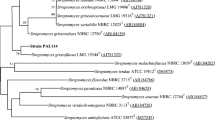Abstract
An endophytic Streptomyces sp. (AC-2) was isolated from the root of Cistanches deserticola Y.C.Ma.. Chemical investigations of the culture broth of AC-2 afforded fifteen compounds including K1115 A (1), tyrosol (2), phenylethylamine derivatives (3, 4), cyclic dipeptides (5–8), nucleosides and their aglycones (9–13), N-acetyltryptamine (14), and pyrrole-2-carboxylic acid (15). Only tyrosol can promote an increase of intracellular cAMP special on GPR12 transfected cells, such as CHO and HEK293, which means it may be a possible ligand for GPR12.
Similar content being viewed by others
References
Ashnagar, A., Bailey, P. D., Cochrane, P. J., Mills, T. J., and Price, R. A., Unusual rearrangements and cyclizations involving polycyclic indolic systems. ARKIVOC (Gainesville, FL, United States), 11, 161–171 (2007).
Dieter, A., Hamm, A., Fiedler, H-P., Goodfellow, M., Mueller, W. E. G., Brun, R., Beil, W., and Bringmann, G., Biosynthetic capacities of Actinomycetes pyrocoll, an antibiotic, antiparasitic and antitumor compound produced by a novel alkaliphilic streptomyces strain. J. Antbiot., 56, 639–646 (2003).
Eidne, K. A., Zabavnik, J., Peters, T., Yoshida, S., Anderson, L., and Taylor, P. L., Cloning, sequencing and tissue distribution of a candidate G protein-coupled receptor from rat pituitary gland. FEBS 292, 243–248 (1991).
Fu, T. and Lin, J., Chemical study on secondary metabolites from Mensamaria intercedens. Journal of Oceanography in Taiwan Strait, 23, 33–37 (2004).
Hendea, D., Laschat, S., Baro, A., and Frey, W., Diastereoselective alkylation of a proline-derived bicyclic lactim ether. Helv.Chim.acta, 89, 1984–1909 (2006).
Ignatov, A., Lintze, J., and Schaller, H. C., Role of the G-protein-coupled Receptor GPR12 as high-affinity receptor for sphingosylphosphorylcholine and its expression and function in brain development. J. Neurosci., 23, 907–914. (2003).
Jiangsu New Medical College, “The Chinese Medicine Dictionary”, Shanghai People’s Publishing House, Shanghai, 895 (1977).
Kahela, P., Halmekoski, J., and Reijonen, M., Some further observations of human serum albumin binding and decomposition of tyramine derivatives-N-and O4-propionyl tyramines. Farmaseuttinen Aikakauslehti, 85, 15–18 (1976).
Lao, Y., Jiang, T., Li, J., Fu, H., and Lin, W., Chemical study on secondary metabolites from Ascidian, Styela clava. Zhongguo Haiyang Yaowu, 20, 12–15 (2001).
Lefkowitz, R. J., The superfamily of heptahelical receptors. Nat. Cell. Boil., 2, 133–136 (2000).
Naruse, N., Goto, M., Watanabe, Y., Terasawa, T., and Dobashi, K., K1115 A, a new anthraquinone that inhibits the binding of activator protein-1 (AP-1) to its recognition sites. II. Taxonomy, fermentation, isolation, physicochemical properties and structure determination. J. Antibiot., 51, 545–552 (1998).
Oleinikova, G. K., Ivchuk, O. I., Denisenko, V. A., Chaikina, E. L., Menzorova, N. I., Nedashkovskaya, O. I., and Kuznetsova, T. A., Indolic metabolites from the new marine bacterium Roseivirga echinicomitans KMM 6058T. Chem. Nat. Compd., 42, 713–717 (2006).
Schulz, B., Sucker, J., Aust, H. J., Krohn, K, Ludewig, K., Jones, P. G., and Doring, D., Biologically active secondary metabolites of endophytic Pezicula species. Mycol. Res., 9, 1007–1015, (1995).
Song, Z. H., Modi, W., and Bommer, T. I., Molecular cloning and chromosomal localization of human genes encoding three closely related G protein-coupled receptors. Genomics, 28, 347–349 (1995).
Stark, T. and Hofmann, T., Structures, sensory activity, and dose/response functions of 2,5-diketopiperazines in roasted cocoa nibs (theobroma cacao). J. Agric. Food Chem., 53, 7222–7231 (2005).
Stierle, A., Strobel, G., and Stierle, D., Taxol and taxane production by taxomyces andreanae, an. endophytic fungus of Pacific Yew. Science, 260, 214–216 (1993).
Takaya, Y., Furukawa, T., Miura, S., Akutagawa, T., Hotta, Y., Ishikawa, N., and Niwa, M., Antioxidant constituents in distillation residue of awamori spirits. J. Agric. Food. Chem., 55, 75–79 (2007).
Tanaka, S., Ishii, K., Kasai, K., Yoon, S. O., and Saeki, Y., Neural expression of G protein-coupled receptors GPR3, GPR6, and GPR12 up-regulates cyclic AMP levels and promotes neurite outgrowth. J. Biol. Chem., 282, 10506–10515 (2007).
Uhlenbrock, K., Gassenhuber, H., and Kostenis, E., Sphingosine 1-phosphate is a ligand of the human gpr3, gpr6 and gpr12 family of constitutively active G protein-coupled receptors. Cell. Signal., 14, 941–953 (2002).
Author information
Authors and Affiliations
Corresponding authors
Additional information
These authors made equal contribution to this paper.
Rights and permissions
About this article
Cite this article
Lin, ZJ., Lu, XM., Zhu, TJ. et al. GPR12 Selections of the metabolites from an endophytic Streptomyces sp. Asociated with Cistanches deserticola . Arch. Pharm. Res. 31, 1108–1114 (2008). https://doi.org/10.1007/s12272-001-1276-4
Received:
Revised:
Accepted:
Published:
Issue Date:
DOI: https://doi.org/10.1007/s12272-001-1276-4




